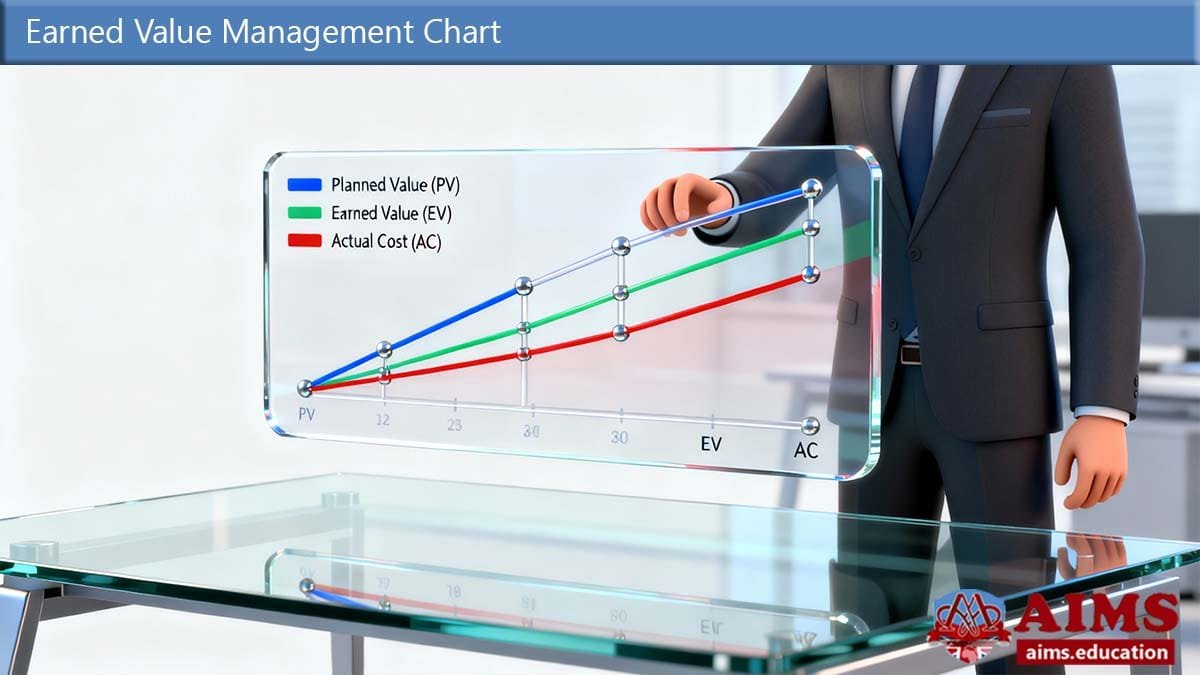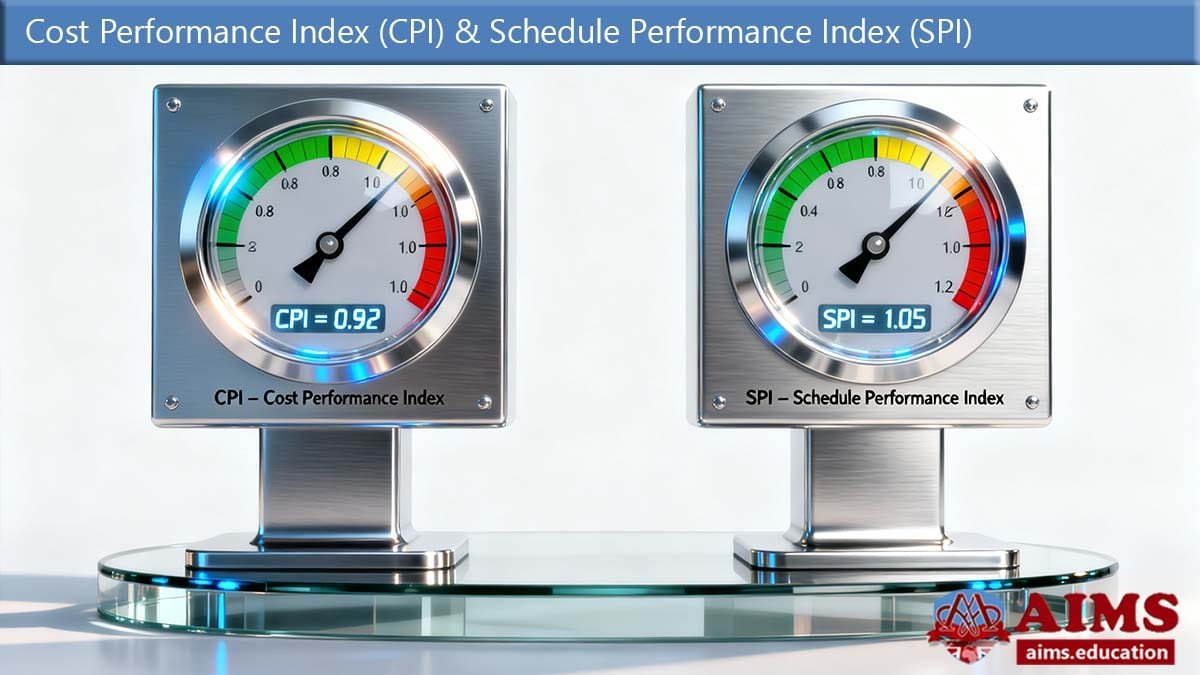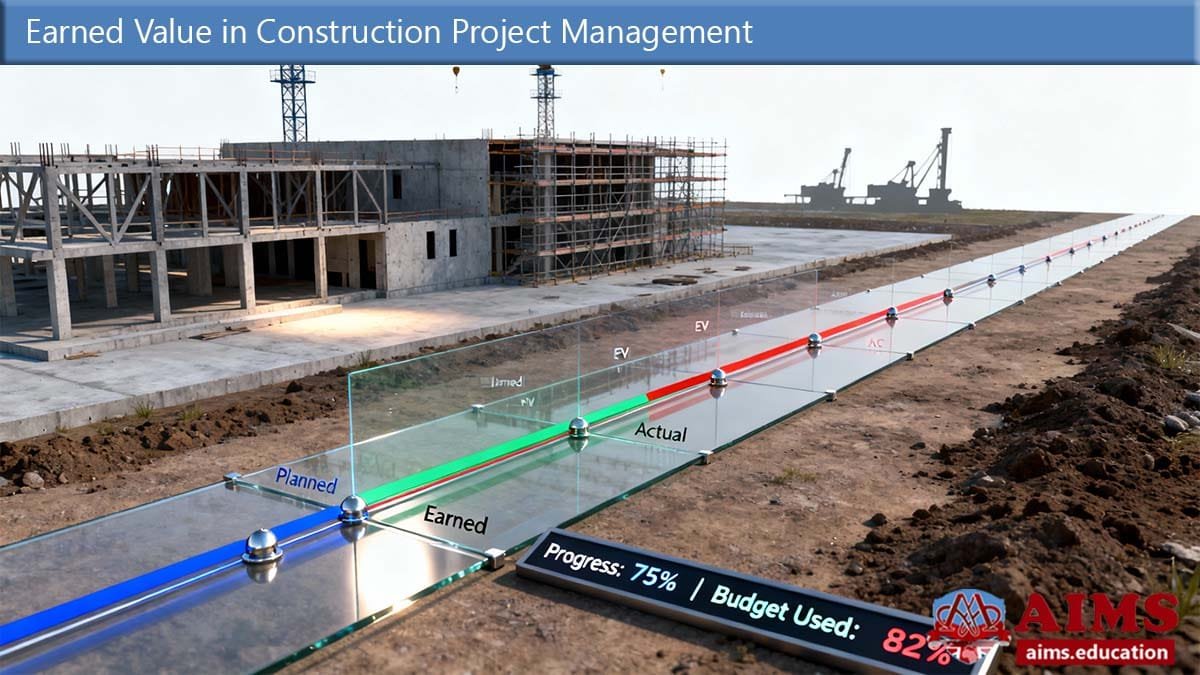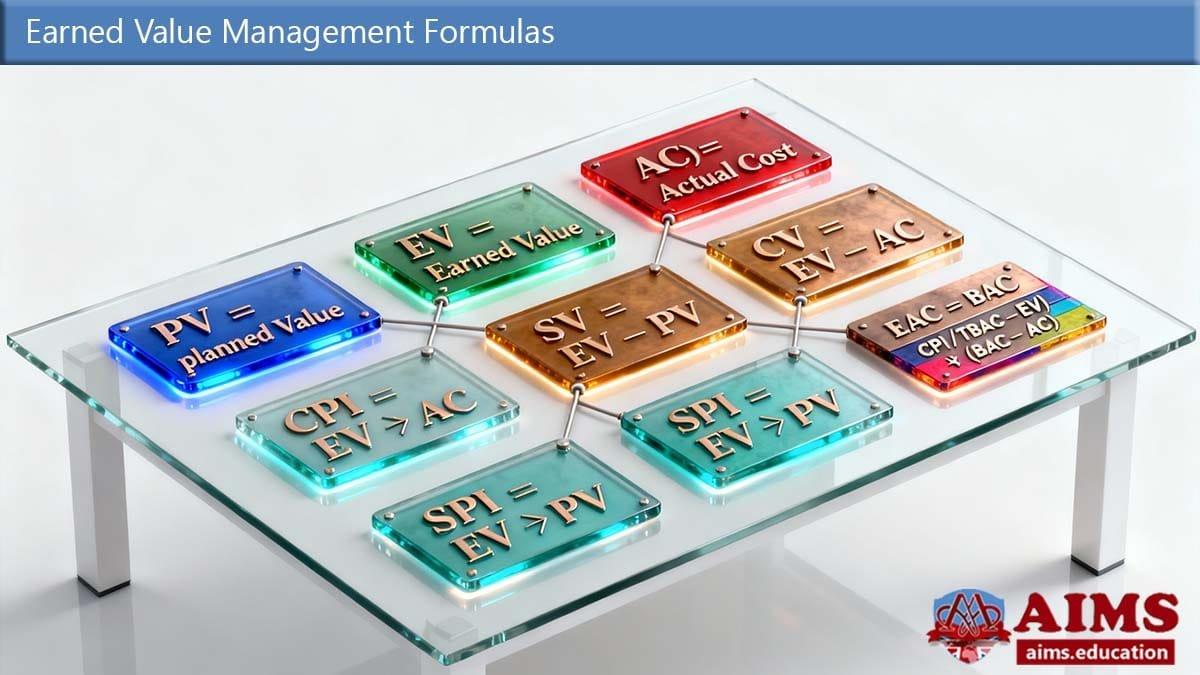What is Earned Value Management?
Earned Value Management (EVM) is a systematic technique used to measure and monitor project performance by comparing the value of work planned, the value of work actually completed, and the actual cost incurred. In simple terms, earn value managment provides a factual way to understand how efficiently a project is progressing in relation to its budget and schedule.
As a key analytical tool, earned value management transforms data into insight, helping teams interpret earned value in project management to determine whether work is on track, behind, or exceeding expectations.
Why Earned Value Management is Important?
Ever wondered why some projects look “on track” until, suddenly, they’re not? Imagine a bridge halfway built, the budget half spent, and yet—no one truly knows whether progress equals performance. That’s where Earned Value Management steps in. It’s the quiet mathematics of truth in project management, translating time and cost into insight.
This lecture explores earned value in project management, from what earned value management is to how to calculate earned value. And, from cost and schedule performance indices (CPI, SPI) to real-world applications.

1. Role of Earned Value Management (EVM) in Performance Measurement
Project management has evolved—from Gantt charts pinned on corkboards to AI-driven dashboards analysing hundreds of data points in real time. Yet amidst this technological renaissance, one method endures: Earned Value Management (EVM). It’s not new. Its roots stretch back to the U.S. Department of Defense in the 1960s, but it continues to guide governments, corporations, and NGOs alike. Why? Because it fuses scope, time, and cost into a single performance language.
Earned value management is like a project’s truth serum. It reveals the difference between “what we planned to do” and “what we’ve actually achieved.” Managers who master it gain not only insight but foresight, but also predicting outcomes before they unfold.
“You can’t manage what you can’t measure—and you can’t measure what you don’t define.”
Earned Value Management defines performance in quantifiable terms, transforming intuition into data-driven decision-making.
Before diving into formulas or indices, let’s first build a shared understanding of what earned value really is and why it continues to be essential to project success, even in Agile or hybrid environments.
2. Foundations of Earned Value Management
a. What Is Earned Value Management?
Earned Value Management (EVM) is a systematic project control technique that measures project performance by comparing planned work, completed work, and actual costs. In essence, it answers three questions every project manager should ask:
- Where are we supposed to be? (Planned Value – PV)
- Where are we now? (Earned Value – EV)
- How much have we spent? (Actual Cost – AC)
By analysing these three components together, managers can see whether they are ahead or behind schedule, over or under budget, and, crucially, why.
b. The Three Core Variables: PV, EV, and AC
- Planned Value (PV) represents the authorised budget for work scheduled to be completed by a given point in time. It’s the baseline expectation—how much value you expected to have earned by now.
- Earned Value (EV) reflects the value of work actually performed, expressed in monetary terms using the project’s budget rate. It’s not about cost spent but value produced.
- Actual Cost (AC) is the amount actually spent for the work performed. It includes all direct and indirect costs associated with the delivered portion.
When these three are compared, the real story of project performance unfolds. If EV exceeds PV, your project is ahead of schedule; if EV exceeds AC, you’re under budget. But if both fall short, alarms should ring.
c. The Power of Integration
What makes EVM revolutionary is its integrative nature. Unlike traditional cost tracking, which focuses solely on expenses, or schedule tracking, which focuses only on timelines, EVM merges both perspectives into one coherent narrative. This is why even modern, AI-enhanced project management software still includes EVM dashboards—it quantifies progress with precision.
In practice, EVM data informs everything from executive dashboards to funding decisions. For government contractors, it’s often mandatory; for private firms, it’s a competitive advantage.

3. Core Earned Value Formulas
Let’s demystify the “numbers” behind earned value management. These formulas are not just academic exercises. They are diagnostic tools. They tell you whether your project’s heartbeat is strong or irregular.
a. Variances: The Early Warning System
Two key variances form the basis of all EVM analysis: Cost Variance (CV) and Schedule Variance (SV).
- Cost Variance (CV) = EV – AC
This measures cost performance. A positive value means you’ve spent less than expected for the achieved work (good news). A negative value means you’re over budget. - Schedule Variance (SV) = EV – PV
This measures schedule performance. A positive result indicates you’re ahead of schedule, while a negative one means you’re behind.
For instance, if your:
- EV is £75,000,
- AC is £80,000, and
- PV is £85,000,
Then:
- CV = £75,000 – £80,000 = -£5,000 → over budget
- SV = £75,000 – £85,000 = -£10,000 → behind schedule
Numbers like these give managers the ability to act early, not react late.
b. Performance Indices: The Efficiency Lens
Variance alone is helpful but limited. That’s why project managers rely on indices—ratios that standardise performance across time and cost dimensions:
- Cost Performance Index (CPI) = EV ÷ AC
- Schedule Performance Index (SPI) = EV ÷ PV
These indices express performance efficiency as a ratio. A CPI or SPI of 1.0 means you’re on target. Greater than 1.0 indicates better-than-expected performance; less than 1.0 signals trouble.
For example, a CPI of 0.9 means you’re only earning 90 pence of value for every pound spent, a subtle yet powerful insight that encourages corrective action.
c. Forecasting the Future: EAC and TCPI
One of EVM’s most powerful features is its predictive capability. Using earned value data, we can forecast how the project will perform if current trends continue.
- Estimate at Completion (EAC): the predicted total cost at project completion.
Common formula: EAC = BAC ÷ CPI, where BAC is the Budget at Completion. - To Complete Performance Index (TCPI): the efficiency required to meet the original budget.
Formula: TCPI = (BAC – EV) ÷ (BAC – AC)
When CPI and SPI data are updated regularly, EAC and TCPI offer an almost crystal-ball-like projection of your project’s financial future.
Pro tip: Combine CPI and SPI trends to identify systemic issues. If both are below 1.0 for consecutive reporting periods, your project may require a baseline review or scope re-evaluation.

4. Real-World Examples and Scenarios
a. Construction Project Example
Consider a bridge construction project with a total budget (BAC) of £1 million. After three months:
- The project planned to complete 40% of the work (PV = £400,000).
- The actual work done is 30% (EV = £300,000), and
- The actual cost spent is £450,000 (AC = £450,000).
Let’s calculate:
- CV = EV – AC = £300,000 – £450,000 = -£150,000 (over budget)
- SV = EV – PV = £300,000 – £400,000 = -£100,000 (behind schedule)
- CPI = 0.67 → For every £1 spent, only 67p of value was earned.
- SPI = 0.75 → The project is progressing at 75% of the planned rate.
These numbers reveal not just performance issues but the underlying narrative: the project’s cost efficiency and time progress are both lagging. Management intervention is urgent.
b. IT Software Development Example
An agile development team has a £500,000 budget. After four sprints, EV = £250,000, AC = £220,000, and PV = £200,000.
In this case:
- CV = £30,000 (under budget)
- SV = £50,000 (ahead of schedule)
- CPI = 1.14 (excellent cost efficiency)
- SPI = 1.25 (excellent schedule performance)
Such results indicate healthy performance and resource optimisation. The team can potentially reinvest savings into quality improvements or additional features.
c. Public Sector Project Example
In public infrastructure projects, transparency and accountability are paramount. EVM enables government project offices to report objectively on taxpayer-funded initiatives. When auditors examine CPI and SPI trends, they can assess whether funds are used efficiently without political bias.
In essence, earned value management is not just about numbers, it’s about trust. It ensures that project stakeholders, from citizens to sponsors, can see evidence-based progress rather than promises.

5. The Benefits of Earned Value Management
a. Objective Performance Insight
Perhaps the greatest advantage of earned value in project management is its objectivity. Unlike traditional progress reports, which may rely on subjective judgement, EVM uses quantifiable data. It converts progress into metrics that can be verified and audited.
b. Early Warning of Risks
By tracking CV and SV regularly, EVM provides early visibility of deviations. Project managers can act proactively; adjusting resources, negotiating scope, or revising schedules before small issues become crises.
c. Improved Stakeholder Communication
Stakeholders often struggle to interpret project jargon. EVM metrics bridge that gap. A simple statement like “Our CPI is 0.92 and SPI is 1.05” succinctly conveys efficiency and timing in a way that executives or sponsors can easily grasp.
d. Better Forecasting and Decision-Making
Through the EAC and TCPI formulas, EVM empowers managers to predict final outcomes. This makes it easier to justify additional funding or schedule changes using factual evidence.
e. Compliance and Professional Standards
Many industries—especially aerospace, defence, and construction, require formal EVM reporting. Adopting EVM not only strengthens compliance but also improves credibility in audits and funding reviews.
6. Challenges and Limitations
a. Data Accuracy and Availability
EVM depends heavily on accurate, timely data. If progress tracking or cost recording is inconsistent, results become misleading. In practice, data discipline is often the hardest part of EVM implementation.
b. Complexity and Training Needs
While the formulas themselves are straightforward, interpreting them correctly requires experience. Many teams misjudge CPI and SPI trends without considering external factors like resource availability or change requests.
c. Integration with Agile and Hybrid Methods
In Agile projects, where scope and priorities evolve rapidly, traditional EVM can feel rigid. However, modern adaptations like Agile EVM use story points or deliverable value to measure progress instead of strict budget baselines. The principle remains the same—measure value earned, not just effort spent.
d. Misinterpretation and Overconfidence
Numbers can create an illusion of certainty. A project may show good CPI and SPI ratios while quality or stakeholder satisfaction quietly deteriorates. Hence, EVM should complement, not replace, qualitative assessments.
7. EVM in the Age of Digital Transformation
With AI and analytics now embedded in project management tools, earned value management has entered a new era. Modern platforms like Microsoft Project, Primavera, and Asana use automation to collect and interpret EVM metrics in real time.
Machine learning can even identify patterns, such as persistent CPI drops in certain project phases, and recommend corrective actions automatically. Meanwhile, visual dashboards display EVM indicators through dynamic charts, enabling leadership teams to make faster, evidence-based decisions.
Modern insight: The future of project control lies not in replacing EVM, but in enhancing it with AI and predictive analytics. Technology amplifies the human decision-maker; it doesn’t substitute them.
8. Best Practices for Implementation
- Start with clear baselines. Define scope, schedule, and budget precisely before applying EVM.
- Collect data consistently. Automate progress reporting where possible.
- Train your team. Ensure everyone understands the meaning of EV, PV, and AC.
- Review metrics frequently. Monthly or sprint-level EVM updates maintain momentum.
- Complement EVM with qualitative insights. Pair numbers with narrative reports for balanced decisions.

Conclusion:
Earned Value Management isn’t just a spreadsheet exercise; it’s a philosophy of accountability. It demands transparency, accuracy, and reflection. Projects succeed not because they spend less, but because they understand more.
As the world embraces digital transformation, EVM stands firm as a bridge between tradition and innovation—grounding modern methods in timeless principles of control and foresight.
In a world obsessed with speed, Earned Value reminds us that precision still matters.
So, whether you’re building bridges, deploying software, or managing research grants, mastering EVM gives you more than data. It gives you the confidence to lead with clarity.
